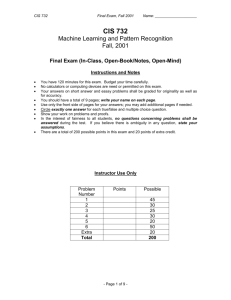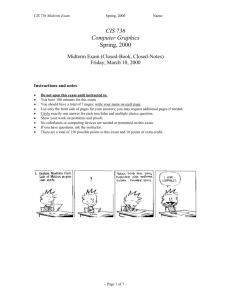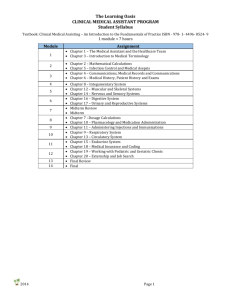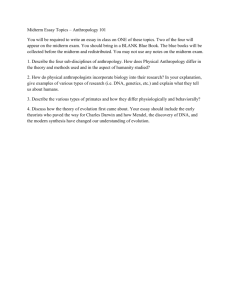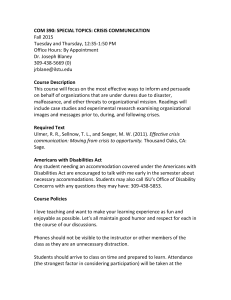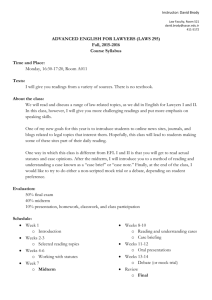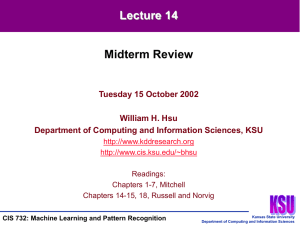MS Word format
advertisement
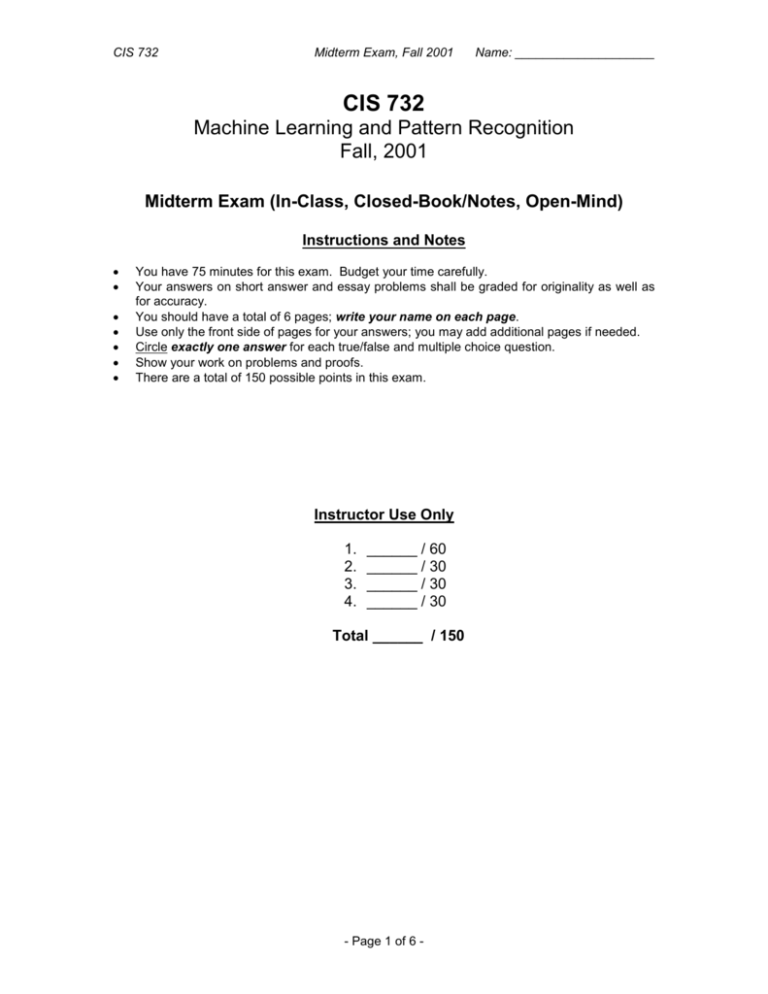
CIS 732 Midterm Exam, Fall 2001 Name: ____________________ CIS 732 Machine Learning and Pattern Recognition Fall, 2001 Midterm Exam (In-Class, Closed-Book/Notes, Open-Mind) Instructions and Notes You have 75 minutes for this exam. Budget your time carefully. Your answers on short answer and essay problems shall be graded for originality as well as for accuracy. You should have a total of 6 pages; write your name on each page. Use only the front side of pages for your answers; you may add additional pages if needed. Circle exactly one answer for each true/false and multiple choice question. Show your work on problems and proofs. There are a total of 150 possible points in this exam. Instructor Use Only 1. 2. 3. 4. ______ / 60 ______ / 30 ______ / 30 ______ / 30 Total ______ / 150 - Page 1 of 6 - CIS 732 Midterm Exam, Fall 2001 Name: ____________________ 1. True/False (15 questions, 4 points each) Circle exactly one answer per problem. a) T F In concept learning, the initial version space is guaranteed to contain the target concept. b) T F Find-S finds the maximal (least general) consistent generalization of the observed training data. c) T F Given consistent examples, an unbiased learner may fail to find the target concept even if it belongs to the (finite) hypothesis space. d) T F lg(|H|) VC(H) e) T F The VC dimension of half-spaces in the plane is 3. f) The ID3 algorithm is guaranteed to find optimal decision trees. T F g) T F Validation set accuracy can be used as an overfitting control criterion. h) T F A 2-layer feedforward ANN can represent any bounded continuous function to arbitrarily small error. i) T F A Winnow can be used to learn monotone disjunctions, but not arbitrary disjunctions. j) T F If uniform priors are assumed over priors, MAP estimation reduces to ML estimation. - Page 2 of 6 - CIS 732 Midterm Exam, Fall 2001 Name: ____________________ k) T F MAP estimation approximates the expectation of h(x) over H. l) Assuming constant time to compute I(X; Y), the Chow-Liu algorithm for learning tree-structured Bayesian networks takes (n2 lg n) time in the number of variables, when implemented using a heap. T F m) T F All tree-structured Bayesian networks admit the Naïve Bayes assumption. n) T F All Naïve Bayes classifiers have a tree structured Bayesian network model. o) T F Each node in a Bayesian network is assumed to be conditionally independent of its nondescendants, given its immediate parents. 2. Multiple Choice (5 questions, 6 points each) Circle exactly one answer per problem. a) Which term describes the use of an m-of-n language for describing a concept? A) Preference bias B) Representation bias C) Inductive bias D) Hypothetical bias E) Bias-variance tradeoff b) Which of the following are measures of expressiveness? A) I. VC-dimension of a hypothesis space B) II. Size of a hypothesis space C) III. Mistake bounds for a learning algorithm D) I and II but not III E) I, II, and III c) What type of anti-overfitting method is validation-based stopping in backprop? A) Prevention B) Avoidance C) Identification D) Recovery E) None of the above d) In time series prediction, which type of model is well-suited for a concept defined as a prepositional function over a short time window? A) Gamma memory B) Exponential trace C) Feedforward ANN D) Moving average E) Time-delay ANN e) What does the P(D | h) term in the BIC/MDL criterion correspond to? A) Residual error B) Redundancy error C) Regression error D) Data error E) Model error - Page 3 of 6 - CIS 732 Midterm Exam, Fall 2001 3. Definitions (6 questions, 5 points each) Give your definition in a complete sentence. a) Learning – b) Hypothesis space – c) (Efficiently) PAC learnable – d) Multi-layer perceptron – e) Type I statistical error – f) Bayes Optimal Classifier – - Page 4 of 6 - Name: ____________________ CIS 732 Midterm Exam, Fall 2001 Name: ____________________ 4. Problem Solving (1 question, 30 points). Version spaces and the candidate elimination algorithm. Consider the following set of attributes: Study: Intense, Moderate, None Difficulty: Easy, Hard Sleepy: Very, Somewhat Attendance: Frequent, Rare Hungry: Yes, No Thirsty: Yes, No PassTest: Yes, No Suppose we have the data set: Example 1 2 3 4 Study Intense Intense None Intense Difficulty Normal Normal High Normal Sleepy Extremely Slightly Slightly Slightly Attendance Frequent Frequent Frequent Frequent Hungry No No No Yes Thirsty No No Yes Yes Earn-A Yes Yes No Yes Consider the space H of conjunctive hypotheses, which, for each attribute, either: indicates by a “?” that any value is acceptable for this attribute, specifies a single required value (e.g., Normal) for this attribute, or indicates by a “” that no value is acceptable. Let a version space (a subset of consistent hypotheses in H) be represented by an S set (specific boundary, at the top) and a G set (general boundary, at the bottom). Suppose the 4 training examples above are presented in order. a) Draw a diagram showing the evolution of the version space for concept Earn-A given the training examples, by writing down S1, G1, S2, G2, S3, G3, S4, and G4. If the G set does not change given a new example, just write Gi+1 = Gi next to the drawing of Gi (similarly for S). - Page 5 of 6 - CIS 732 Midterm Exam, Fall 2001 Name: ____________________ b) Write down the hypotheses in the final version space (the ones that lie between S4 and G4 according to the partial ordering relation Less-Specific-Than). c) In the final version space, draw lines between hypotheses that are related by this relation. For example, there should be a line between <?, Normal, ?, ?, ?> and <?, Normal, ?, Frequent, ?, ?>. - Page 6 of 6 -

